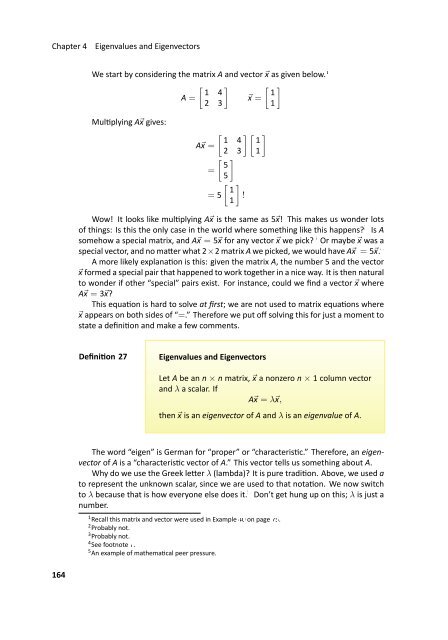Fundamentals of Matrix Algebra, 2011a
Fundamentals of Matrix Algebra, 2011a
Fundamentals of Matrix Algebra, 2011a
You also want an ePaper? Increase the reach of your titles
YUMPU automatically turns print PDFs into web optimized ePapers that Google loves.
Chapter 4<br />
Eigenvalues and Eigenvectors<br />
We start by considering the matrix A and vector ⃗x as given below. 1<br />
[ ] [ ]<br />
1 4<br />
1<br />
A =<br />
⃗x =<br />
2 3<br />
1<br />
Mulplying A⃗x gives:<br />
[ ] [ ] 1 4 1<br />
A⃗x =<br />
2 3 1<br />
[ ] 5<br />
=<br />
5<br />
[ ] 1<br />
= 5 !<br />
1<br />
Wow! It looks like mulplying A⃗x is the same as 5⃗x! This makes us wonder lots<br />
<strong>of</strong> things: Is this the only case in the world where something like this happens? 2 Is A<br />
somehow a special matrix, and A⃗x = 5⃗x for any vector ⃗x we pick? 3 Or maybe ⃗x was a<br />
special vector, and no maer what 2×2 matrix A we picked, we would have A⃗x = 5⃗x. 4<br />
A more likely explanaon is this: given the matrix A, the number 5 and the vector<br />
⃗x formed a special pair that happened to work together in a nice way. It is then natural<br />
to wonder if other “special” pairs exist. For instance, could we find a vector ⃗x where<br />
A⃗x = 3⃗x?<br />
This equaon is hard to solve at first; we are not used to matrix equaons where<br />
⃗x appears on both sides <strong>of</strong> “=.” Therefore we put <strong>of</strong>f solving this for just a moment to<br />
state a definion and make a few comments.<br />
.<br />
Ḋefinion 27<br />
Eigenvalues and Eigenvectors<br />
.<br />
Let A be an n × n matrix, ⃗x a nonzero n × 1 column vector<br />
and λ a scalar. If<br />
A⃗x = λ⃗x,<br />
then ⃗x is an eigenvector <strong>of</strong> A and λ is an eigenvalue <strong>of</strong> A.<br />
The word “eigen” is German for “proper” or “characterisc.” Therefore, an eigenvector<br />
<strong>of</strong> A is a “characterisc vector <strong>of</strong> A.” This vector tells us something about A.<br />
Why do we use the Greek leer λ (lambda)? It is pure tradion. Above, we used a<br />
to represent the unknown scalar, since we are used to that notaon. We now switch<br />
to λ because that is how everyone else does it. 5 Don’t get hung up on this; λ is just a<br />
number.<br />
1 Recall this matrix and vector were used in Example 40 on page 75.<br />
2 Probably not.<br />
3 Probably not.<br />
4 See footnote 2.<br />
5 An example <strong>of</strong> mathemacal peer pressure.<br />
164

















